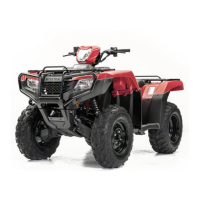
Do you have a question about the Honda FourTrax Foreman TRX520FM1 2020 and is the answer not in the manual?
| Brand | Honda |
|---|---|
| Model | FourTrax Foreman TRX520FM1 2020 |
| Category | Offroad Vehicle |
| Language | English |
Information on safety labels located on the ATV.
Explanation of safety messages using signal words like DANGER, WARNING, CAUTION.
Key safety recommendations and guidelines for operating the ATV.
Details and location of various safety labels on the ATV.
Diagrams showing the location of various ATV controls and instruments.
Explanation of the ATV's dashboard indicators and display functions.
Description of the ignition switch function for starting and stopping the engine.
How to use the 4WD switch to select between 2WD and 4WD modes.
Explanation of the front differential lock and speed limiter override features.
How to use the P/R lever for parking brake and reverse gear.
Information on the accessory socket and its usage for powering devices.
Explanation of the electronically controlled electric power steering system.
Guidance on evaluating personal and ATV readiness before riding.
Recommendations for appropriate riding gear and protective clothing.
Importance and sources for ATV operator training and skill development.
Minimum recommended operator age and safety warnings for underage riders.
Information that the ATV is designed for one rider only.
Guidance on pre-ride inspections for ATV safety and function.
Detailed checklist of items to inspect before operating the ATV.
General information and warnings about loading cargo and passengers onto the ATV.
Specific weight capacities for the ATV's rider, cargo, and towing.
Best practices for safely loading cargo and towing trailers.
Recommendations for selecting and installing accessories.
Advice against unauthorized modifications and their potential risks.
Essential safety rules and precautions for operating the ATV.
Emphasis that the ATV is designed for off-road use only.
Importance of maintaining proper hand and foot placement for balance and control.
Guidance on selecting appropriate speeds based on conditions and experience.
Tips for safely navigating challenging or unknown terrain.
Warning against performing stunts like wheelies or jumps.
Steps to prepare the ATV before starting the engine.
Detailed steps for starting the ATV's engine.
Procedure for clearing a flooded engine.
Explanation of the system that stops the engine if the ATV overturns.
Instructions for normal and emergency engine shutdown procedures.
Instructions for using the recoil starter when the battery is low.
Diagram and explanation of the sequence for shifting to higher gears.
Diagram and explanation of the sequence for shifting to lower gears.
Information on the front hydraulic disc brakes, including pad wear.
Information on the rear mechanical drum brake, including shoe wear.
Recommended type of brake fluid for the ATV.
Proper techniques for turning the ATV safely on various terrains.
How to handle and avoid skidding or sliding during turns.
Techniques and precautions for safely climbing hills.
What to do if the ATV stalls or rolls backward while climbing a hill.
Techniques for safely descending hills, including body positioning.
How to safely cross or turn on hills and slopes.
Guidance on safely navigating over obstacles like bumps and potholes.
Precautions and procedures for riding the ATV through water.
Special procedures for parking the ATV on inclines or slippery surfaces.
Specific safety measures to take before and during maintenance.
Notes and procedures related to the maintenance schedule.
Key for understanding maintenance procedure codes (I, C, A, L, R).
General information and safety precautions before performing maintenance.
Explanation of why regular maintenance is crucial for ATV performance and longevity.
Advice on planning and preparing for an off-road ATV ride.
List of essential tools and supplies to bring for ATV riding.
Guidance on what supplies to carry on the trail based on ride conditions.
Recommendations for safely transporting the ATV.
General advice on storing the ATV for extended periods.
Detailed steps for preparing the ATV for storage to prevent deterioration.
Steps to take when removing the ATV from storage and preparing it for use.
Tips for being an environmentally responsible ATV owner.
Practical advice for dealing with common problems encountered while riding.
Troubleshooting steps for engine starting or performance issues.
How to handle a flat tire, including temporary and permanent repair.
Troubleshooting steps for high coolant temperature warnings.
How to check and replace blown fuses on the ATV.
Post-crash safety checks and procedures for inspecting the ATV.
Steps to take if the ATV key is lost.
Troubleshooting for a low or dead battery and starting procedures.
Guidance on dealing with failures of critical ATV components.
Information on VIN and engine serial numbers for identification.
Key dimensions, capacities, and technical specifications of the ATV.
Recommendations for the initial operating period to ensure ATV reliability.
Information on exhaust emission requirements and control systems.
Information on oxygenated fuels, their use, and limitations.
List of available manuals and how to order them.
Details on the ATV's warranty coverage, terms, and conditions.
Information on obtaining warranty service and handling issues with dealers.
Contact information and procedures for inquiries and feedback.
Information on dealer services, parts, and sales support.
Tips for preventing common and expensive ATV repair issues.
Summary of initial and regular maintenance intervals.
Checklist of items for pre-ride inspection.
Summary of fuel type, octane, capacity, and reserve.
Summary of engine oil recommendations and capacities.
Summary of tire sizes and recommended pressures.
Summary of recommended spark plug type.
Summary of coolant type and mixture.
Summary of fuse types and ratings.
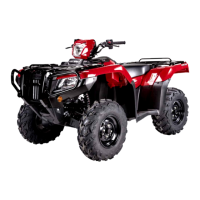
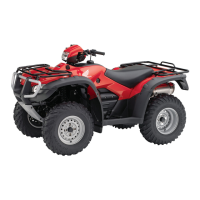


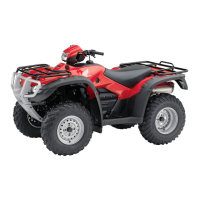


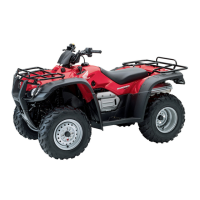
